CPA embraces and respects our multicultural community. We have translated the ‘Reducing the risk of CMV during pregnancy’ brochure into five languages: Arabic, Chinese (Simplified), Chinese (Traditional), Hindi, Vietnamese
What is CMV?
CMV is a common virus. When healthy people are infected they frequently have no symptoms. CMV is spread from person-to-person through contact with saliva, urine, tears, nasal mucus and intimate contact. Infected infants and young children, who may otherwise remain well, can easily pass this virus on to others.
Therefore, people who care for or work with young children are at increased risk of infection through activities like nappy changes. If a pregnant woman is infected with CMV, there is a risk that her unborn baby will also become infected. This is called congenital CMV (cCMV).
CMV can cause injury to the baby’s developing brain. In Australia, more than 400 babies every year are born with a life-long disability caused by CMV – but despite this, research has found that just 14% of Australian women aged 20-40 have heard of CMV.



CMV Awareness Videos (with or without captions) that can be shown in clinic waiting rooms. We can freely provide these videos to run in your clinic waiting areas. Please request through our online form.
In Australia, around 2,000 children every year will be born with CMV – making it the most common infectious cause of disabilities. A common virus, CMV is a known cause of epilepsy, deafness and cerebral palsy.
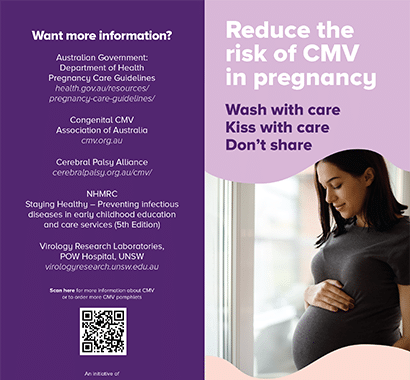

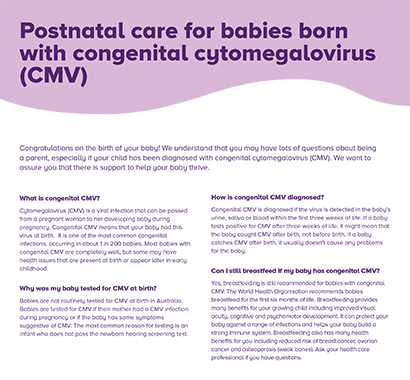
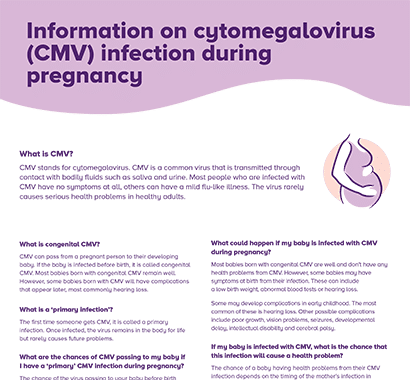
CPA embraces and respects our multicultural community. We have translated the ‘Reducing the risk of CMV during pregnancy’ brochure into five languages: Arabic, Chinese (Simplified), Chinese (Traditional), Hindi, Vietnamese
Download these as pdfs and/or request free printed copies through our online form.
As a result of a partnership with Cerebral Palsy Alliance, The University of Sydney, CMV Australia and the Australian College of Midwives, a new free eLearning course: Congenital Cytomegalovirus (CMV) – Prevention is in Your Hands is now available. Developed with midwives, obstetricians, infectious diseases specialists, researchers and families who have been impacted by CMV, this interactive course aims to update midwives on how CMV can adversely affect babies and highlight preventive strategies for reducing the risk of infection during pregnancy.
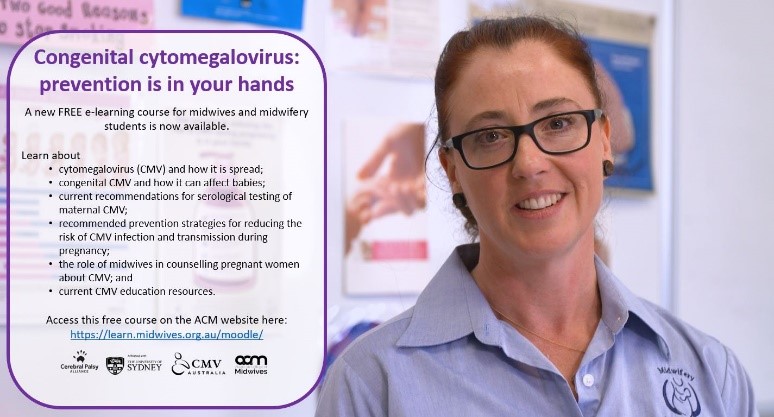
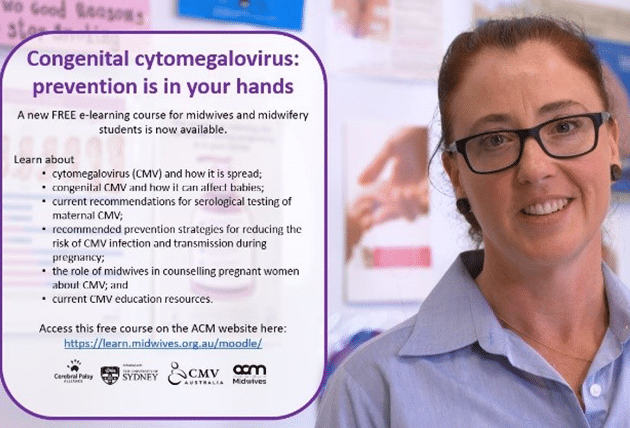
As a result of a partnership with Cerebral Palsy Alliance, The University of Sydney, CMV Australia and the Australian College of Midwives, a new free eLearning course: Congenital Cytomegalovirus (CMV) – Prevention is in Your Hands is now available. Developed with midwives, obstetricians, infectious diseases specialists, researchers and families who have been impacted by CMV, this interactive course aims to update midwives on how CMV can adversely affect babies and highlight preventive strategies for reducing the risk of infection during pregnancy.

This Infections in Pregnancy module provides an important update for GPs on congenital CMV and syphilis, both of which can have devastating consequences for the developing baby. CMV is the most common congenital infection resulting in childhood disability in Australia, yet less than 20% of Australian GPs are confident in providing advice on CMV in pregnancy. Syphilis notifications in women of childbearing age have quadrupled between 2015 and 2020. Untreated syphilis leads to adverse pregnancy outcomes in about 50% of affected pregnancies.
Congenital CMV is a known cause of cerebral palsy. Our researchers from the Cerebral Palsy Alliance Research Institute, The University of Sydney are committed to collaborating with other investigators, professional organisations and advocacy groups to:

To request more information or printed copies of the posters or pamphlets below, please provide your details here:
"*" indicates required fields
This work is possible thanks to partnerships with our wonderful collaborators and funding support through the NH&MRC, the Cerebral Palsy Alliance Research Foundation and our passionate donors.